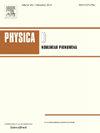分数阶高斯噪声驱动二维翼型系统的逃逸问题与逆随机共振
IF 2.9
3区 数学
Q1 MATHEMATICS, APPLIED
引用次数: 0
摘要
飞机机翼在飞行过程中会遇到复杂的随机载荷,传统的高斯白噪声模型不能很好地描述这些载荷。本文研究了一种具有非线性俯仰刚度的二维翼型,在分数阶高斯噪声作用下,采用Hurst指数参数模拟机翼结构在飞行过程中所经历的复杂随机载荷。我们的研究结果揭示了显著的逆随机共振,其特征是在中等噪声强度下振荡抑制。抗持续噪声(H<0.5)需要更高的强度才能达到最佳抑制效果,而持续噪声(H>0.5)的ISR曲线变化最小。为了理解这种现象的潜在机制,我们在不动点和极限环之间进行了逃逸时间分析。平均首次通过时间分析和概率密度函数都建立了过渡时间和噪声强度之间的指数关系,这种关系在不同的Hurst指数中持续存在,尽管噪声具有非马尔可夫性质。这些发现为现实湍流环境下的翼型系统设计提供了有价值的见解。本文章由计算机程序翻译,如有差异,请以英文原文为准。
The escape problem and inverse stochastic resonance in a two-dimensional airfoil system driven by fractional Gaussian noise
Aircraft wings encounter complex stochastic loads during flight that traditional Gaussian white noise models inadequately represent. This paper examines a two-dimensional airfoil with nonlinear pitching stiffness subjected to fractional Gaussian noise, employing the Hurst index parameter to simulate the complex random loads experienced by wing structures during flight. Our results reveal significant inverse stochastic resonance, characterized by oscillation suppression at intermediate noise intensities. Anti-persistent noise () requires higher intensities for optimal suppression while persistent noise () shows minimal ISR profile variation. To understand the underlying mechanisms of this phenomenon, we conduct escape time analysis between fixed points and limit cycles. Both mean first passage time analysis and probability density functions establish an exponential relationship between transition times and noise intensity that persists across different Hurst indices, despite the non-Markovian nature of the noise. These findings provide valuable insights for airfoil system design in realistic turbulent environments.
求助全文
通过发布文献求助,成功后即可免费获取论文全文。
去求助
来源期刊

Physica D: Nonlinear Phenomena
物理-物理:数学物理
CiteScore
7.30
自引率
7.50%
发文量
213
审稿时长
65 days
期刊介绍:
Physica D (Nonlinear Phenomena) publishes research and review articles reporting on experimental and theoretical works, techniques and ideas that advance the understanding of nonlinear phenomena. Topics encompass wave motion in physical, chemical and biological systems; physical or biological phenomena governed by nonlinear field equations, including hydrodynamics and turbulence; pattern formation and cooperative phenomena; instability, bifurcations, chaos, and space-time disorder; integrable/Hamiltonian systems; asymptotic analysis and, more generally, mathematical methods for nonlinear systems.
 求助内容:
求助内容: 应助结果提醒方式:
应助结果提醒方式:


